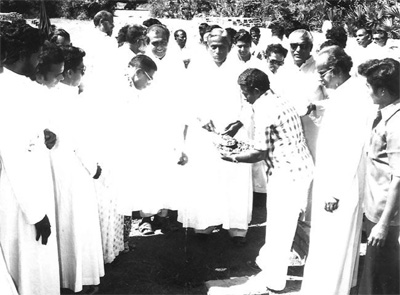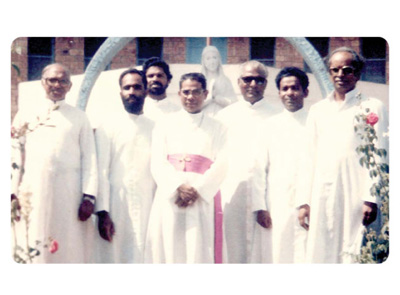HERALDS OF GOOD NEWS
HISTORY
HERALDS OF GOOD NEWS - A SHORT HISTORY
The Society of Heralds of Good News Missionary Society was founded by Rev. Dr. Jose Kaimlett in 1984 with the approval and blessings of (Late) Rt. Rev. Dr. John Mulagada, Bishop of Eluru. It was in June 1984 that Fr. Jose Kaimlett resigned his charge as the headmaster of St. Ambrose School, Nidadavole and took up the construction of Fr. Jose Memorial Hospital at Vellachinthalagudem. During this time, Bishop John gave him the go-ahead to found the Society. The specific aim of the society is the promotion of vocations to the priesthood, the training of seminarians and the supply of zealous and hardworking missionaries to the dioceses of India and across the world. Today the missionaries of Heralds of Good News are present in 17 countries around the world. The Society strives to promote to the priesthood only those who have been called, through the Society and spares no effort to get them adequately trained. The formation in the Society envelops the human, spiritual, intellectual, pastoral and missionary dimensions.

HGN, being a Missionary Society, carry the Word of God in their hearts, in their minds and their actions. Living and preaching the Word of God is the centre of their life. They receive their fulfilment of the ministry entrusted to them. The Eucharist becomes the Center of their life. It gives direction to carry out their mission. The HGN Missionaries strongly believe in the teachings of the Church and faithfully follow the directives of the local Episcopal Conferences.
They base their Spirituality on reading the Word, listening to it, meditating it and above all acting upon it individually and collectively as a community. Every missionary of HGN, while spending a minimum of an hour of Meditation every day will faithfully follow the Liturgy of the Hours. Daily examination, of Conscience, is faithfully practised. A day of Recollection every month along with Confession and an annual Retreat of six full days strengthens the commitment of every member in the congregation.

Being well aware of the shortage of missionaries in the universal Church, as early as 1971 Father Kaimlett proposed and discussed the idea of establishing an organised missionary venture, at a meeting of certain like-minded priests, and later with his own Bishop while he was still a priest of the diocese of Vijayawada. But this proposal did not have much effect and ended up without success; to quote his own words, “in the divine plan, probably the time was not yet ripe.” The division of the diocese of Vijayawada and the erection of the new diocese of Eluru in December 1976, forced Father Kaimlett to relegate the idea of the new missionary venture to the background.
However, he had not abandoned the idea. He nurtured the hope with confidence, perseverance and determination. His journeys abroad – to the traditionally Christian countries– brought him face-to-face with the urgent need the local churches there had for priests. In one of the manuscripts he recalls the several conversations he had with the late Bishop Joseph Hodges of Wheeling-Charleston, U.S.A, which further helped him in giving a different direction to his original idea of a clerical association and reshaping it to its present orientation, that is, as a clerical society of apostolic life.
Finally, when his own assignment in the diocese was more or less accomplished and the time in the divine plan was ripe, Father Kaimlett began the immediate planning for the missionary society. When bishop John of Eluru gave the formal go-ahead to found the Society, as a preliminary step he called for a meeting of like-minded priests who were his friends and collaborators in the same diocese. The net result was the foundation of the missionary Society of the Heralds of Good News.
On 14 October 1984 after much study and prayerful reflection Bishop John Mulagada placed his zeal of approval on the primary constitutions and formally erected the community of the Heralds of Good News in his diocese as a clerical public association (Cf. cc. 298-326) in accordance with the norms of canon law (Cf. c. 312 §1, 3°). This canonical act was done in view of erecting it later, when it was possible, as a clerical society of apostolic life. However, from that day onwards, for all practical purposes, the said community was considered a clerical missionary society of apostolic life, although its canonical erection as such, came a few years later according to the normal procedure.
It is to be noted that at this stage (i.e. until October 1984), the Society did not have any infrastructure or house of its own. The first prospective members continued their pastoral ministries assigned to them by the diocese in their own parishes. The founder with two seminarians lived in a thatched shed adjacent to the St. Joseph hospital at Vellachintalagudem, which was the last missionary venture of Father Kaimlett as a diocesan priest, before starting the ‘Heralds of Good News.’ Thus the society had a very modest beginning. In the mean time, an agricultural land was acquired for the Society at Kurukuru, an until-then unknown village of the diocese of Eluru. The foundation stone for the first minor seminary of the Society was laid on 12th December 1984 at the outskirt of this tiny little village.

On 2nd February 1985, the first six members, two seminarians and four priests including the founder– after a few days of spiritual retreat and serious reflection under the able guidance of late capuchin friar Fr. Peter Canisius, made their permanent commitment to the society in the presence of the Bishop of Eluru in his private chapel. In the meeting held on the same day the first general government was formed, and Father Kaimlett was unanimously elected the first Superior General and was approved by the Bishop according to the universal laws of Church and the particular norms of the Heralds of Good News.
On June 25, 1985 with the approval of the same bishop the first minor seminary was opened with 27 seminarians in the first house of the Society at Kurukuru. Although since 1984, the Heralds of Good News existed, for all practical purpose, as a society of apostolic life, its canonical erection as such, that is, as a Clerical Society of Apostolic Life of diocesan right came later. In other words, until 1991 the canonical status of HGN was that of a Public Association of Christ’s Faithful (Cf. c. 312). Having observed that the community has reached a considerable growth, Bishop John Mulagada of Eluru, by the ‘Nihil Obstat’ obtained from the Holy See as per can. 579 erected the ‘Heralds of Good News’ as a clerical Society of Apostolic Life of Diocesan Right on May 5, 1991.
The Society continued to grow rapidly. Thus in keeping with its specific purpose it could send missionaries and open houses in different dioceses of India as well as in abroad. By the end of 2000 the society counted around 150 permanently incorporated members with 128 priests who were serving in 27 dioceses (13 dioceses in India and 14 outside India). The members were are present in 21 different houses belonging to the society and engaged in various apostolic activities in accordance with the needs of the place under the instruction of the local Ordinary.
On May 5, 1999 Pope John Paul II, having heard the favourable opinion of the Competent dicastery of the Holy See, namely the Congregation for Institutes of Consecrated Life and Societies of Apostolic Life, raised the missionary society of the ‘Heralds of Good News’ from the diocesan status to a Society of Apostolic Life of Pontifical Right and, thereby approved its revised constitutions.
Characteristic Features and Identity of HGN
The Heralds of Good News is a society of apostolic life that is established after the promulgation of the current Code of Canon Law. Hence, its common nature and identity are very much in conformity with the common laws of the Societies of Apostolic Life, defined in canons 731-746 of the present Code of Canon Law of the Latin Church. According to the Code of Canon Law the essential features of a Society of Apostolic Life, are its apostolic missionary nature coupled with the fraternal life in common but different from the religious institutes.
Arts.1-5 of the Constitutions deal with the nature and purpose of this society. Apostolic mission of the Church coupled with fraternal life in common characterises the Common nature and identity of the society. However, from this common apostolic nature, the Constitutions of the Society of HGN draws-out its specific nature and purpose. Thus art. 2 of the constitution states, the missionary Society of the Heralds of Good news is a “clerical Society of Apostolic Life of Pontifical Right” according to the universal law of the Church and the proper law of the Society. The members live a fraternal life in common in their own special manner, according to the proper law of the Society, and undertake to live the evangelical counsels of chastity, poverty and obedience, through a promise made in accord with the constitutions. Art. 3 further states: The members of the society form one family of God in the Church and strive after perfection through the practice of evangelical counsels dedicating themselves to the service of God and their fellow human beings.



